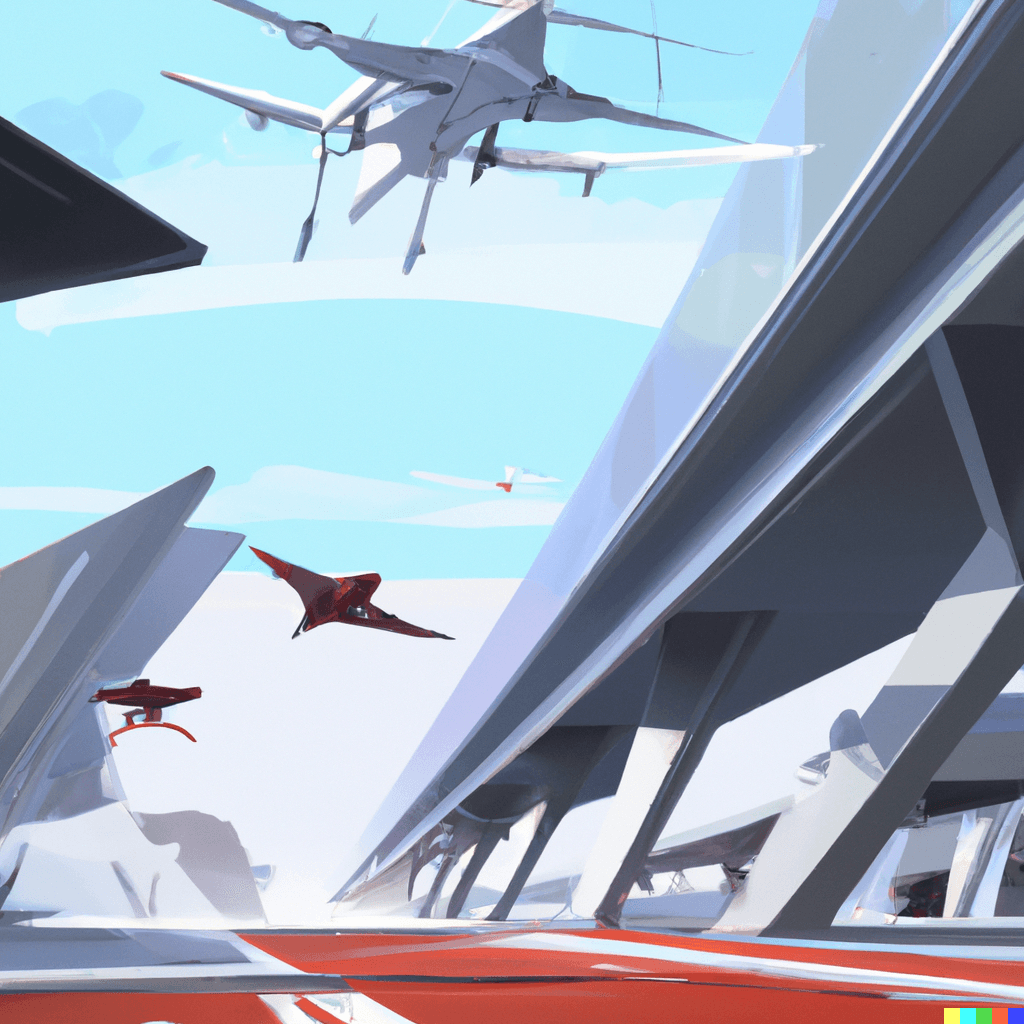Sep 1, 2022
Enabling the future of flight: Moonware mission statement
The year is 2038, and you’ve just arrived at the United Airlines terminal in JFK after taking an Overture flight from a business meeting in São Paulo. It’s Friday afternoon and you’re in a rush to make it to Manhattan for your daughter’s birthday dinner; luckily, United hailed Archer’s electric vertical take-off and landing (eVTOL) aircraft for you in advance for an expedited aerial rideshare trip into the city. As you make the transfer over to the JFK Urban Air Mobility (UAM) terminal, you notice a Halcyon jet landing gracefully on the runway, shy of the hypersonic speeds it was flying at minutes earlier coming from Dubai. You arrive at the UAM terminal, where fellow passengers await their leaps into the city on Lilium jets or Joby aircraft, many of whom were accelerated from the far corners of the world a few hours ago.
Moonware was founded with the belief that multimodal air transportation will become the prime mover of people and goods during the 21st century. From eVTOLs ferrying passengers between cities and suburban areas, to supersonic aircraft and suborbital flights shaving travel time between continents, we are ushering in a new air and space age that will further globalize humanity. Our mission is to enable this next generation of aerial mobility with automated and sustainable airfields.
What we’re building
Moonware optimizes ground handling operations for airlines. HALO is our first product, an airside software operating system designed to streamline aircraft turnaround management by seamlessly coordinating both crews and equipment to service flights on time. Specifically, our platform automates the scheduling and dispatching of ground crews using mobile devices in real time and uses IoT to track ground support equipment (GSE) across the airside. HALO’s core optimizer fuses flight information, vehicle position and ground crew tasks together to create optimal dispatches, and incorporates smart routing to navigate ground crews efficiently across the airfield.
Real-time task allocation and dynamic vehicle routing are examples of features that take place in the cloud, effectively replacing the current use of radio and paper. These time-sensitive operations are migrated over to digital infrastructures that can process the large datasets necessary for task & equipment allocation along with their inherent complexities.
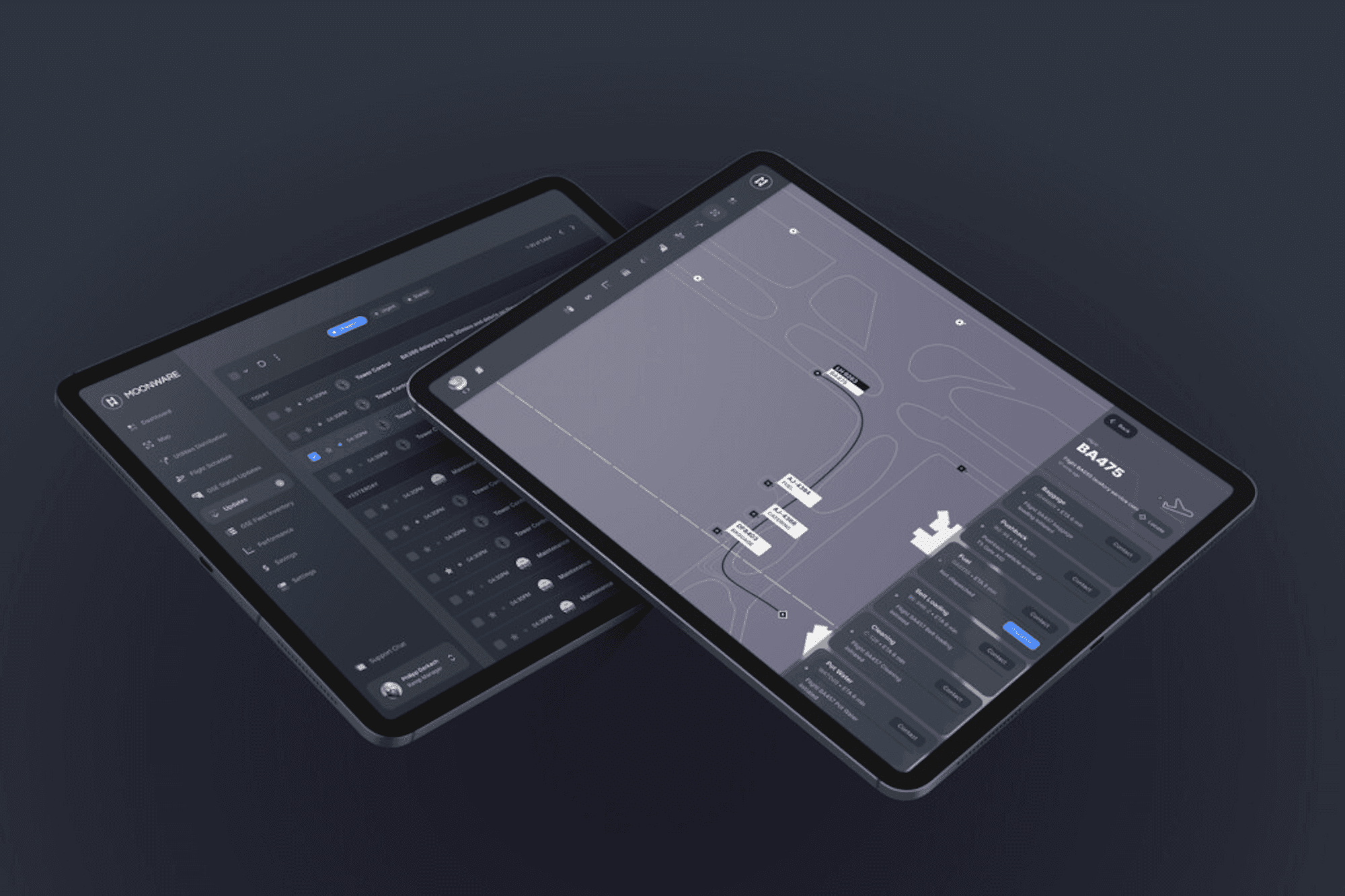
HALO airside software OS. Courtesy of Moonware
This approach enables us to collect large amounts of data that is virtually absent on ground vehicle whereabouts and movements, interactions between ground handling agents, and service time punctuality. Furthermore, by collecting ground data from different airport hubs, we can build robust machine learning models that take into account airfield traffic patterns and airport-specific constraints. We can then use this data to inform where the greatest bottlenecks in ground operations are occurring and how these processes can be augmented by ‘last-mile’ ramp services with autonomous GSE. This is what we call laying the bridge to airfield autonomy.
Why we started Moonware
Moonware’s inception originated in the UAM industry, stemming from a collaboration with Uber Elevate (acquired by Joby Aviation) to develop an autonomous & electric pushback vehicle to tow eVTOL aircraft in vertiports. At the time, the UAM market was still in its early stages, and aircraft manufacturers had yet to lock-in their designs for certification, establish the requirements for infrastructure, and the handling operations necessary to support their operations. Since then, we’ve maintained strong working relationships with the main eVTOL companies, vertiport developers, and industry stakeholders across the globe.
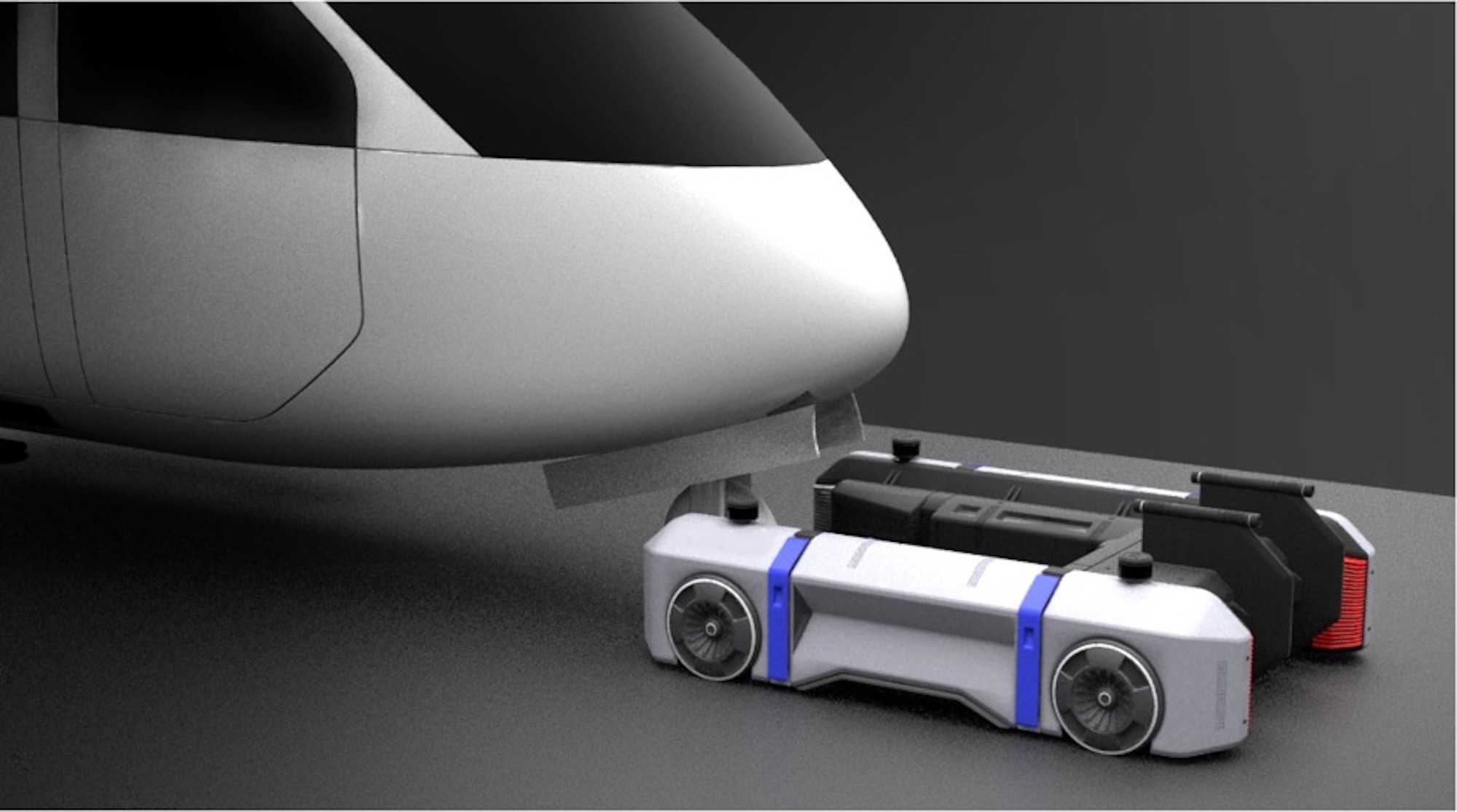
ATLAS autonomous & electric pushback tug for eVTOLs. Courtesy of Moonware
While the UAM industry was maturing in parallel, a tremendous opportunity in commercial aviation quickly became apparent through discovery calls with airlines, airports, GSE manufacturers, and ground handlers. We connected with many industry stakeholders who were excited about implementing autonomous pushback tugs in their operations, but ultimately realized that the vehicles would be largely disconnected from the synchronized and coordinated efforts required to turn around an aircraft. We learned that ground handling is a sector dominated by a handful of companies, if not insourced by airlines, where archaic tools (e.g. walkie-talkie, paper) are prevalent, and the few dedicated enterprise solutions in place fail to address the complexities of dynamic airside operations. It therefore became evident that Moonware’s initial focus should be to lay the digital foundations for the airside, which would gradually inform specific cases for autonomy.
Current state of affairs
In spite of the current advancements in aircraft technology, the infrastructure and processes required to enable advanced aerial ecosystems to flourish have been largely left out of the equation. With some exceptions, airports have not really evolved past the traditional check-in counter and lengthy boarding processes to transit passengers from door to gate.
Today, a slow yet steady rate of airport technology adoption has given us advances such as mobile check-in and boarding passes, digitized security checks, and on-demand inflight entertainment. However, airports are still laden with inefficiencies that impede a truly smooth passenger experience. Fundamentally, the premise of seamless and quick door-to-door journeys can only be achieved when all the individual trip segments in between have been optimized around the same objective. What good is a 1.5 hour hypersonic flight if you’re spending 2+ hours to get through the airport?
On the airside, where aircraft get prepared for their next flight by ground handlers, these inefficiencies have become particularly visible. Ground handling services manage everything from baggage loading to aircraft fueling, cleaning the cabin, and filling it with snacks. It is effectively the backend of the airport, a massive logistical effort requiring an incredible amount of coordination across airlines’ different teams. Despite their importance, ground operations have historically received very little attention.
Aircraft turnarounds (the process of servicing aircraft between flights) are still largely coordinated through radio and paper: ground crews are assigned to a specific flight according to a paper-based timesheet, and walkie-talkie is used to communicate with turnaround managers and other ramp agents as the day progresses. Naturally, most flights never land or depart on time, rendering their initial scheduling instructions worthless. Most of the equipment used on the airport ramp is analog, antiquated (some machinery from the 60s and 70s) and highly underutilized, spending the majority of their day cluttering airport ramp space. Aside from being visually unappealing, free-floating equipment such as container dollies and unit load devices pose a huge foreign object damage risk for aircraft and other crew. The consequences of this negligence have become more pronounced as downstream effects of the COVID-19 pandemic, causing significant suffering for airlines in the form of staff shortages in pilot, cabin and ground crews, leading to the notorious delays and canceled flights that passengers are frustratingly dealing with across airports globally today. Uncoordinated ground handling operations cost airlines $30B+ every year across delays, accidents, and fuel costs.
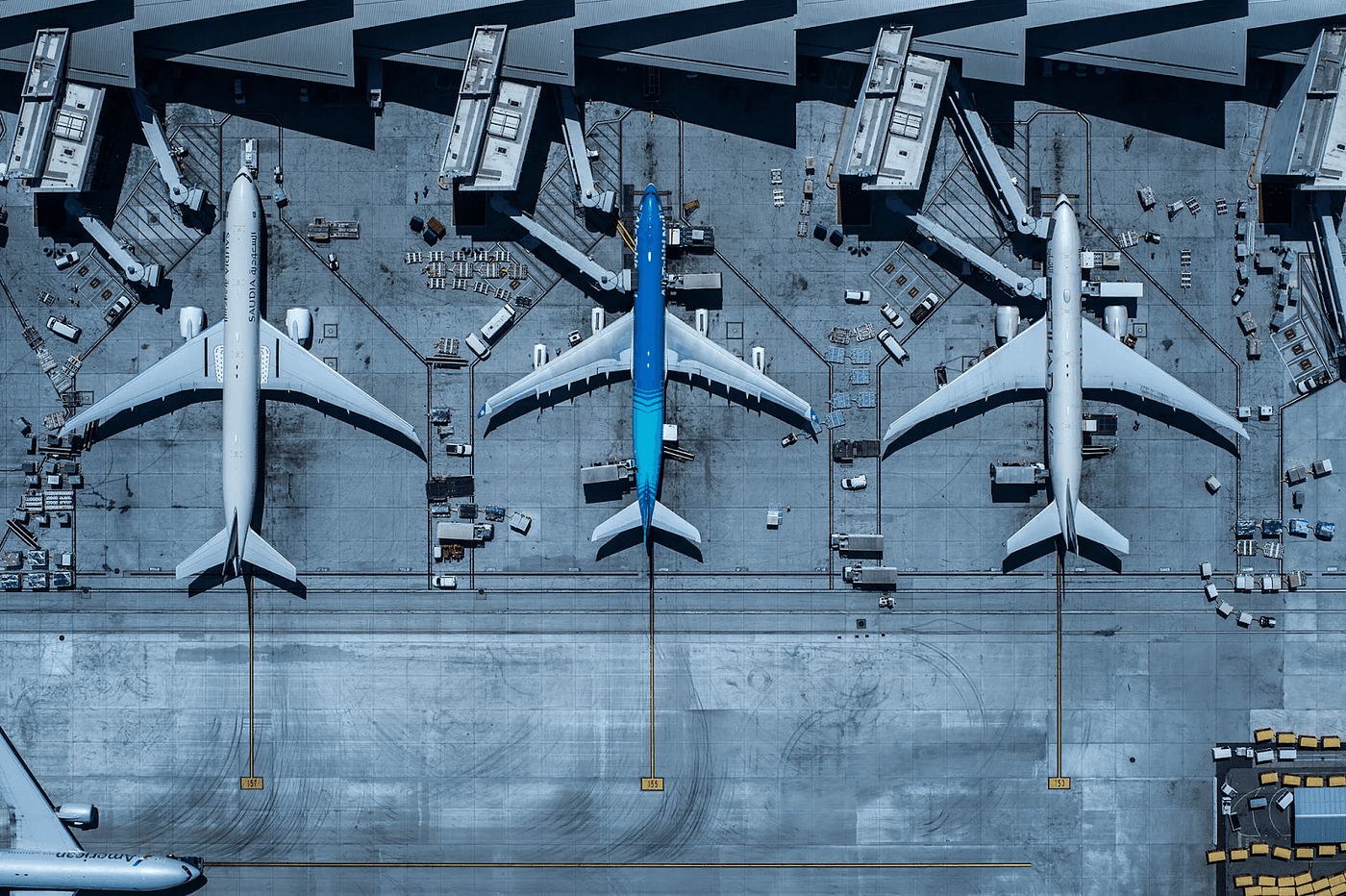
LAX Tom Bradley International Terminal airside. Courtesy of Getty Images
The industry is quickly learning that pandemic recovery is not only about recapturing lost demand, but that pre-pandemic business models need to evolve to withstand 2nd & 3rd order effects of drastic fluctuations in air traffic. Meeting schedule quotas is now a prime objective for airlines, where airside and ground operations are a focal point of the current chaos. Time-sensitive events such as disruptions to flight schedules require modern tools capable of processing large amounts of information in real-time — far beyond what individual ground crews with walkie-talkies can handle. Adopting new systems to increase transparency on airside activities, while automating simple processes (such as dispatching crew and routing vehicles) will go a long way in addressing the operations that are frequently breaking.
These modern tools should address the objective of maximizing airfield throughput. Automated ground handling workflows can reduce turnaround times, delays, and GSE fuel emissions. The real value, however, becomes apparent when observing the network effects of turnaround optimization at scale in airlines’ hubs. Generally, faster turnaround times allow airlines to better meet their on-time performance goals and scheduling requirements. In fact, they are consistently finding ways to improve this. For example, Delta Airlines began pushing back their aircraft at a 45º angle (as opposed to a traditional 90º pushback) in Atlanta Hartsfield Airport, shaving off 1–2 minutes per turnaround. With a scale of approximately 1000 daily flights out of Atlanta, these seemingly insignificant minutes quickly compound to 10–30 additional hours in the airline’s schedule that can be used to add more flights every day. Considering that a full turnaround operation takes about 1.5 hours to complete on average, this small operational adjustment gave Delta an opportunity to create approximately 20 additional daily flight slots across their larger network.
The premise behind Moonware’s value proposition is the same. Automated systems for ground handling operations can enable airlines to significantly increase their daily flight cap. This in turn allows them to generate millions of dollars in additional revenue by using their existing aircraft & GSE fleets more efficiently, without the additional capital expenditure involved with purchasing more assets.
Where do we go from here?
As aircraft become more fuel efficient, electric, and autonomous, airports and the hubs uniting these modes of transport will need to evolve to meet the modern demand for air travel. There is much that can be done to reimagine and improve the airport experience.
In the terminal, for example, the check-in counter could be replaced by a system of individual baggage housing units, embedded with weight sensors and RFID tags. Passengers place their baggage in a drop-off container upon arrival at the airport, and scan the container using their phone to link their flight information to that container. The container in turn registers the baggage weight automatically and sends it to the appropriate conveyor belt associated with the passenger’s flight. Adopting standardized containers could make it easier for handlers to transfer baggage between the terminal and vehicles, and facilitate loading into the aircraft underbelly. Alaska Airlines recently launched a similar initiative with electronic bag tags, aimed at reducing the drop-off time of checked baggage by 40%.
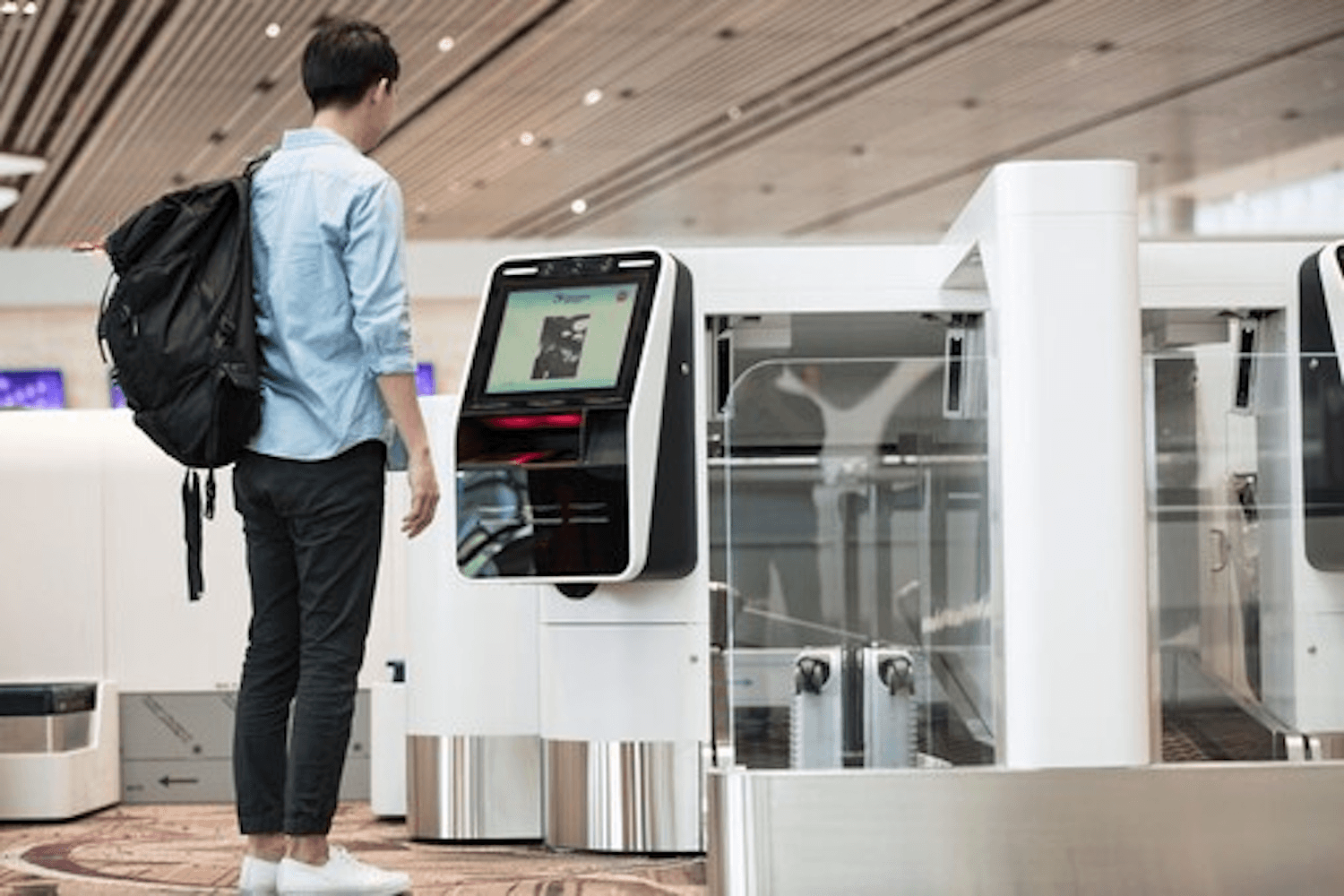
Changi airport automated baggage drop-off. Courtesy of Changi Airport Group
In the control tower, companies like Airspace Intelligence are working with airlines to improve the future of air traffic management. Their proprietary algorithms help air traffic controllers make data-driven decisions to route flights subject to a number of airspace constraints and dynamically-changing scenarios. Airspace Intelligence will play a large role in advancing the future of air traffic and migrating flight routing decisions over to the cloud.
Finally, down on the airside ramp, advances in software offer a tremendous opportunity to depart from archaic turnaround procedures and streamline passenger experiences.
Intelligent airfields for intelligent aircraft
Aircraft manufacturers in advanced aerial mobility are designing next-generation aircraft around autonomous flight. During the initial years of service, these aircraft will use existing infrastructure and air traffic control procedures, although they will be equipped with advanced software-enabled functionalities. Gradually, as manufacturing scales and different classes of airspace become increasingly congested, managing high volumes of air traffic will congruently require more powerful tools capable of issuing real-time flight plans and dynamic route updates. Future flight will effectively be coordinated by advanced airspace management software.
Moonware aims to be the ground complement of advanced airspace management, by building efficient surface movement systems enabled by the advances in software. HALO will become the de facto airport OS, which will power an end-to-end system of operators, smart GSE and aircraft to handle flights autonomously from touchdown to takeoff. In the same way the Moon is a satellite to the Earth, future vehicles under our network will be satellites to aircraft, seamlessly connected through software and hardware products — hence our name, Moonware.
This mission requires us to maintain a broad presence across the industry from day one, in established markets such as commercial and cargo aviation, to the nascent ones such as Urban Air Mobility, where we will help build the foundations for a new frontier of aviation.

An airfield in the not so distant future. Generated by DALL·E 2, courtesy of Moonware
The advances of the coming century are nothing short of what we imagined at the height of the jet age in the 60s and 70s — flying cars, supersonic and space travel. While these dreams were put on hold during the past few decades, the long-awaited chapter of advanced human flight is currently being written.
If you are moved by how globalized humanity has become, join us in building the technologies that will enable the next generation of aerial mobility to further connect our civilization on Earth and beyond.
